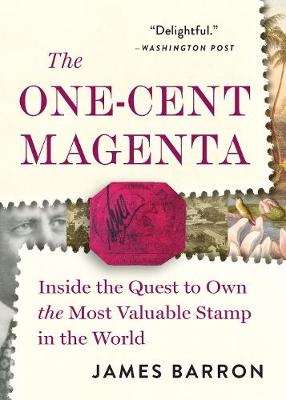
When it was issued in 1856, it cost a penny. In 2014, this tiny square of faded red paper sold at Sotheby's for nearly $9.5 million, the largest amount ever paid for a postage stamp at auction. Through the stories of the eccentric characters who have bought, owned, and sold the one-cent magenta in the years in between, James Barron delivers a fascinating tale of global history and immense wealth, and of the human desire to collect. One-cent magentas were provisional stamps, printed quickly in what was then British Guiana when a shipment of official stamps from London did not arrive. They were intended for periodicals, and most were thrown out with the newspapers. But one stamp survived. The singularone-cent magenta has had only nine owners since a twelve-year-old boy discovered it in 1873 as he sorted through papers in his uncle's house. He soon sold it for what would be $17 today. (That's been called the worst stamp deal in history.) Among later owners was a fabulously wealthy Frenchman who hid the stamp from almost everyone (even King George V of England couldn't get a peek); a businessman who traveled with the stamp in a briefcase he handcuffed to his wrist; and John E. du Pont, an heir to the chemical fortune, who died while serving a thirty-year sentence for the murder of Olympic wrestler Dave Schultz. Recommended for fans of Nicholas A. Basbanes, Susan Orlean, and Simon Winchester, The One-Cent Magenta explores the intersection of obsessive pursuits and great affluence and asks why we want most what is most rare.
I have always thought postage stamps were neat. I admit I'm the ass in the post office line asking if I can see all the current stamps when I get to the counter, so I can pick out the coolest ones. (This, by the way, is unheard of in Australia; I've only found one post office where the lady is nice enough to let me pick my own stamps.)
But I have never collected stamps. The hobby holds no appeal for me and never has. What I am hooked on, is rarity. The idea that there are only x number of something in the world sucks me in, no matter what x is. I understand the collectors that want to own what no one else owns; I don't have the ego for it, but the idea of owning something that is completely unique is a seductive one.
That's why I bought this book on a whim. That and the cover. James Barron is a New York Times journalist, who stumbled on the story of the one-cent magenta stamp at a cocktail party; the article he wrote about it led to this book, where he chronicles the path this odd-looking stamp took on it's way to becoming the world's most valuable stamp, selling at auction in 2014 for 9.5 million USD, to Stuart Weitzman, he of the red-soled shoe empire.
This is where journalists who write books shine, especially for someone like me, who knows almost nothing about stamps or philately. Let's face it, stamps do not lend themselves to page-turning drama, and philately needs all the help it can get if it's to appeal to those outside the bubble. Barron succeeded beyond my expectations. I completely enjoyed this book and spent all day reading it. His journalistic style brought the stamp's history to life, and even though he has a bit of fun with the eccentricities of "Stamp World" as he calls it, I thought he did a brilliant job describing the passion and dedication of the hobby in a sympathetic way.
I'm thoroughly surprised and delighted at how much I enjoyed this book.
Reading updates
-
20 January, 2018:
Started reading
-
21 January, 2018:
Finished reading
-
21 January, 2018:
Reviewed
